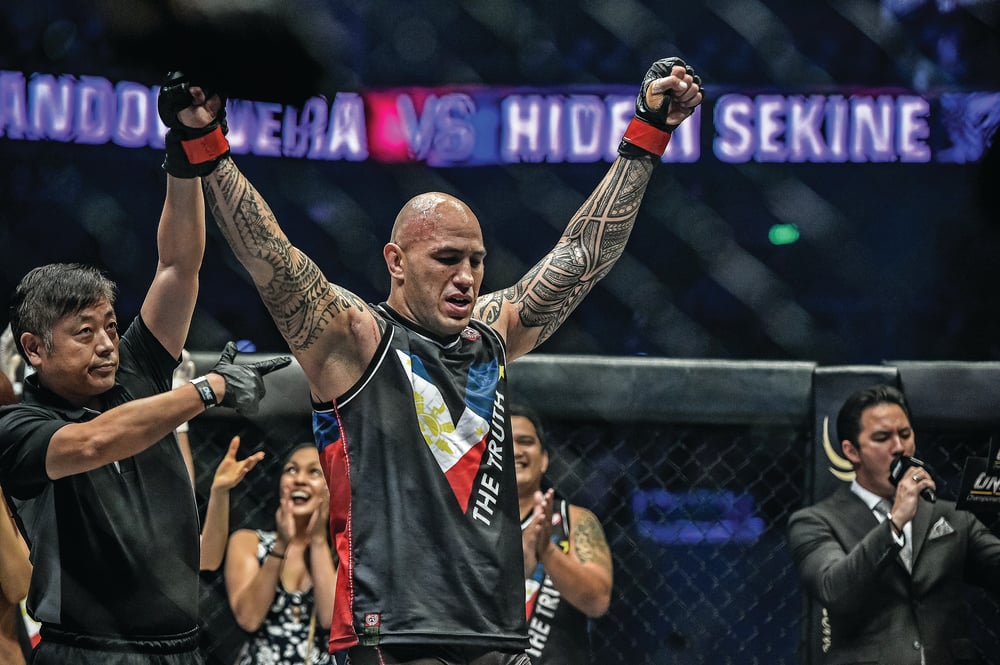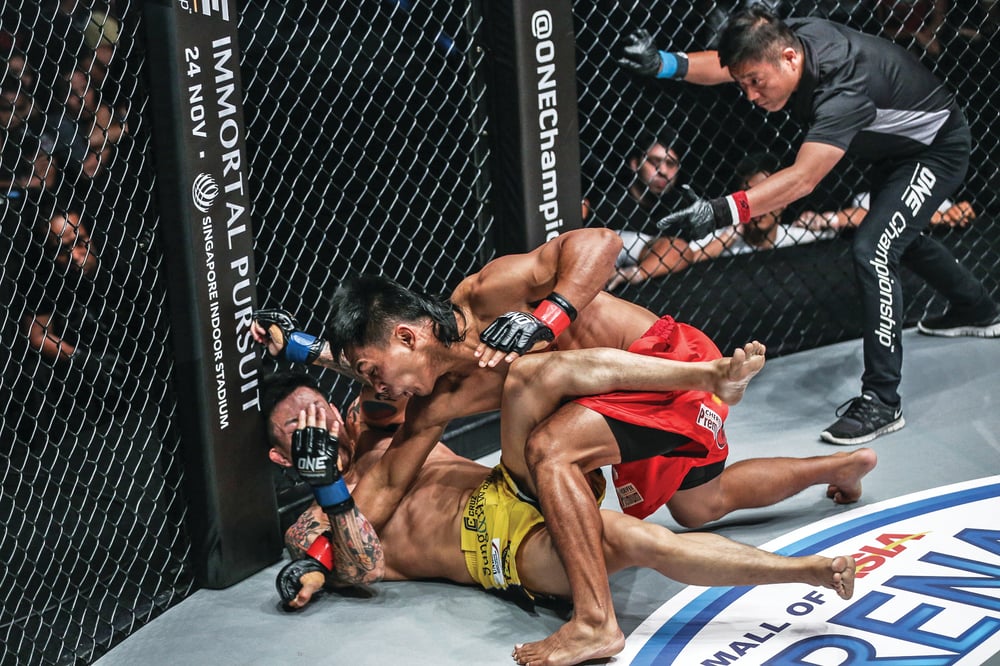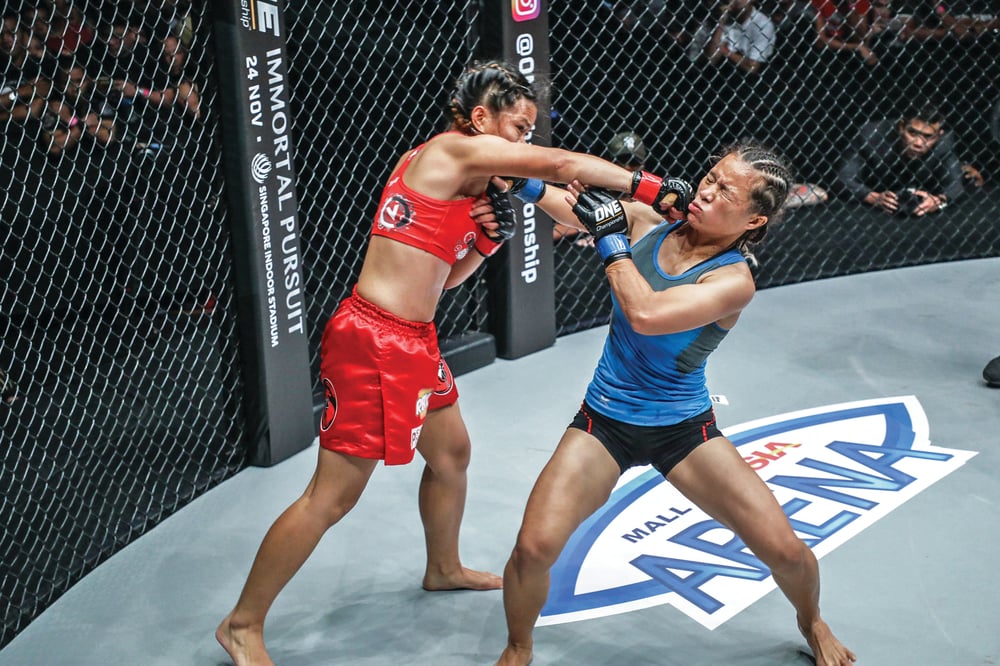
Issue 163
January 2018
Boxing has always been king in the Philippines, but its MMA stars are fighting to take the country's combat sports crown.
Think combat sports in the Philippines and you probably think of Manny Pacquiao – the eight-division world champion boxer whose popularity transcended his homeland as he became one of the planet’s biggest sporting icons. When he fought, 100 million Filipinos stopped to watch their hero.
But ‘Pacman’ is coming to the end of his illustrious career. Now 39 years old and a senator, his time as the world’s number one pound-for-pound boxer is over. His homeland needs new heroes, and, while a few pugilists are doing the business at the world level, MMA’s exploding popularity suggests mixed martial artists are set to be the new objects of a nation’s admiration.
The signs have been there for a while. When the UFC took Chuck Liddell to the Mall of Asia in 2008 for a publicity tour, thousands of people showed up to see him do an open workout. (Filipino-Americans Brandon Vera and Mark Munoz got similar reactions over the next few years.) The organization also made a splash when it eventually brought its first show there – an attendance of more than 13,000 making it the eighth-biggest Fight Night show ever.
But before the Octagon made any live-event impact, ONE Championship had marked the country as one of its key markets following its fifth show, in Quezon City, which almost doubled its previous record attendance.
The organization has only gone from strength to strength since, routinely filling the 20,000-capacity Mall of Asia Arena with screaming Pinoy fans. So successful have they been, in fact, Pacquiao himself invested and bought himself a stake in the company.
RISING TIDE
There are a number of Filipinos furnishing the ONE roster from gyms all over the islands, but Team Lakay from the city of Baguiao – the home of superstar and defending lightweight champion, Eduard Folayang (more on him later) – has taken a starring role when the cage comes to the capital of Manila. Five of the team were booked to star when ONE returned to its most successful live event market in November, for a show dubbed ‘Legends of the World’.
“I’m so excited,” says its CEO, Chatri Sityodtong, as he looks forward to the show. “The Philippines market is so exciting, we’re growing, the fans are unbelievable. There are so many Filipino fighters who are world-class.”
A catalyst for interest in native fighters was one of the Lakay band, Honorio Banario. He became well-known when he became the inaugural ONE featherweight champion in February 2013. Before then, Filipino fighters enjoyed some notoriety through the Universal Reality Combat Championship (URCC) organization and Guam-based PXC. But this was the first time one of them had captured a major title.
“Getting the belt changed my life forever,” explains ‘The Rock’, who travelled to support his teammates despite not being scheduled to fight. “A lot of people in the Philippines at that time didn’t know MMA, only UFC, but now ONE is getting really popular and they recognize a lot of fighters representing the Philippines. It makes me happy that people are recognizing a lot of young Filipino talent. It motivates them to train hard and want to become world champions.”
One example of that effect is Joshua Pacio, another member of Team Lakay who was booked on the undercard. The 21-year-old’s career has taken off. He has fought 14 times in the last three years to become one of the most exciting prospects in the organization and a beneficiary of the surging pro le of MMA.
“When I was still an amateur, MMA started booming in the Philippines,” he says. “I was still fighting in local promotions in Manila and Baguiao. The crowd said I was very entertaining and a lot of guys started following me. I entered ONE Championship and now there’s a lot of people and magazines messaging me on Facebook.
“I’m feeling happy and proud. As MMA becomes more popular, when they talk about MMA, our name will be talked about also.”
Many of his teammates, including Geje Estaquio – a veteran of 15 fights with main-event experience – are also tasting greater recognition and popularity. “It’s been building for two years,” says ‘Gravity’. “It went fast since we got the first belt with Banario. This time last year, when Eduard got the lightweight belt, every time we met people in the street we hear, ‘Let’s take a picture!’ It’s fun, but it’s hard (laughs). Sometimes you’re eating and you’re in the middle of enjoying your food. It’s a stress, but it’s fun.”

Brandon Vera has to cope with that kind of attention more than most. He was already well-known when he signed for ONE, following eight years in the UFC, but his popularity soared to new heights after three main and co-main event slots. Despite being born in Norfolk, Virginia, he is no plastic Filipino. ‘The Truth’ speaks the language and has relocated to live in the homeland of his father and step-mother. He is adored.
“It’s too hard to describe how that feels,” he says, “It would be like asking Neil Armstrong what it felt like to walk on the moon. Unless you did it, there’s really no way of explaining it. The words will never fully describe the exact feeling. The easiest way to explain it is it feels right. It just feels perfect. This is the peace that has been missing in my life. I’m getting goosebumps just talking about it. I enjoy performing in Asia because I feel the love all around.”
Such is Vera’s popularity, getting him in the cage has been an issue. The heavyweight champion spent the entirety of 2017 breaking into the burgeoning Filipino lm industry.
“We’re trying to get him to fight as often as possible but the Filipino fans just love him,” says Sityodtong. “They’re offering him movie deals and he’s so busy. He’s promised, next year he’s going to fight two or three times. As long as nobody offers him more movies, he’ll be back in the cage.”
THE LANDSLIDE
Despite Vera’s star power, the biggest draw in Filipino MMA is unquestionably Eduard Folayang. ‘Inspirational’ seems like a woefully inadequate word to describe ‘Landslide’, who was born into poverty as one of nine children five of whom died due to sickness. Neither of his parents could read or write, but both worked multiple jobs in order to give him an education so he could escape those hardships.
He began practicing martial arts, which earned him a scholarship in college and led to a job as a high school teacher. During this time, he competed as a member of the Philippine Wushu Team – winning 11 major medals including three Southeast Asian Games golds – before transitioning to the cage, competing at home in the URCC and Singapore’s Martial Combat organization.

He was signed by ONE to headline its first ever show in Singapore in 2011 and continued to be an importantfixture on fight cards in the following years, until reaching superhero status in 2016 with an upset knockout of Japanese legend Shinya Aoki. The win landed him the lightweight title. It also saw ‘Landslide’ become a role model for the Filipino people and kick-start the next stage of the country’s fascination with mixed martial arts.
“Almost 90% didn’t believe I could win,” he says. “When I won that title, the fighters in the Philippines understood there’s no mountain you can’t climb if you persist and do your part as a climber.
“It was very emotional. I can’t believe it was real. I beat this legend and escaped all his submission attempts. It was a different kind of joy. It’s not the end of the journey but those kinds of moments in life make me realize that hard work pays off.”
His stock went stratospheric and took him to a level of fame in his native country that eclipses most combat sports athletes anywhere in the world. He draws eyeballs and attention like Conor McGregor – though his notoriety far exceeds ‘The Notorious’ in his corner of the world. His first title defense, against Ev Ting last April, became the most-watched MMA show in Philippines TV history with a 26% peak ratings share. The UFC’s best – McGregor vs. Eddie Alvarez at UFC 205 – is 7%.
It’s not just his success that’s a appealing, though. The 33-year-old’s fighting style exemplifies that of all the members of Team Lakay. He’s always in shape and constantly going forward with ashy spinning strikes. He’s also the perfect role model – gracious, well-spoken and constantly promoting a positive philosophy on life and his career. That’s exemplified when he addresses rumours that he was close to retirement after a vicious KO loss in 2014.
“I didn’t want to retire in that kind of situation,” he says. “If people will remember me, they should be inspired, and that’s what I do.
“The best thing I can do as a champion is to inspire the youth of the Philippines. It’s not the circumstances that will predict how we live, it’s how we see the potential that we have inside and unleash it, so people can have a good relationship in society and help each other to achieve a goal for this nation. “

It’s no surprise that Folayang’s gone on to earn high-end endorsements and sponsorships, as well as a deal with a lm production company. He’s no longer teaching English and physical education, and Vera, a self-confessed fan, reckons he’s not far o reaching a similar status as Pacquiao, who emerged from comparable lowly beginnings to become idolized by the public. “When Manny Pacquiao, the legend, fights, there is zero crime that day, zero traffic,” he says. “It’s almost like 28 Days Later, where a guy wakes up in a hospital bed and nothing’s happening on the streets. If you’ve ever been to the Philippines, that sounds absurd.
“Eduard Folayang is probably two fights away from that status. He’s a home-grown fighter, very humble and he looks like an action figure. He’s one of the nicest guys in the world. Plus, because of his background, everybody can understand or relate to what he came from. He lost family at a young age and the reason for this was because they didn’t have any money. That’s a story that almost every Filipino family in the world can relate to.”
Folayang, as humble as any fighter you’ll see, dismisses those comparisons with a dismissive laugh. Despite his fame and popularity, it still seems unfathomable that he’s mentioned in the same breath as his hero.
“Of course, I never think that way and it never came to my mind they’d be saying I’m the next Pacquiao because I was just watching him on TV,” he says. “I was encouraged when he was at my fight and I thought, wow, the one I was watching is watching me! It gives me a lot of inspiration and motivation to continue in this sport and this legacy. The best thing I can do is manage my health, my training and career so I can give 100% and the results will follow.”

FIGHT NIGHT
When Friday night rolls around, thousands of Filipino fans line the streets, snaking around the exterior of the Mall of Asia. When the doors to the venue open, they charge in and await the appearance of their heroes representing them and their country.
It’s enough to make the supporting members of Team Lakay, those who don’t get to fight, a little jealous.
“Fighting in your homeland with your people surrounding you, cheering, shouting for you – the energy is totally different,” says Eustaquio. “Filipinos are known to be some of the greatest fans in the world. I fought here several times and every time I strike, the crowd goes with me. Every time I give a good kick or punch, they shout. It’s a positive thing. As a fighter, you’re encouraged to do more.”

All five Lakay fighters set to compete are excited to be cheered by that support. All except Pacio, that is, who has been matched against another Filipino – Roy Doliguez, a former boxer who competed internationally before switching to MMA in 2011. Pacio wonders whether he’ll receive the full backing of the crowd.
“The day they announced I’d fight Doliguez, it sucked, because I knew I’d be fighting in front of 20,000 Filipinos,” he says. “My feeling is not good, but this is MMA. This is what we do and we put on a good show, so it’s OK!”
‘Passion’ needn’t have worried. Though the arena is not quite full – most likely because of the Manila traffic, which is beyond chaotic and gridlocked – the roar that greets his spinning back-fist KO is huge. So too is the reception for Gina Iniong, who earns her second win in the ONE cage with a second-round TKO to bring the curtain down on the preliminary portion of the event.
With the exception of a few VIP boxes, there isn’t an empty seat in the house by the time the main card comes around, and the atmosphere is electric. The decibel count then continues to rise when Kevin Belingon fights Kevin Chung.
Attacking with a trademark Lakay-style assault of powerful kicks, every strike is met with huge cheers that are matched only by the one that greets the announcement of a unanimous decision victory.
“It’s a big help for me having the support of my countrymen,” says Belingon. “I’m more con dent to fight. The support of the Filipino fans is 100%. They really support Filipino fighters. We have other supporters in other countries, but not like this.”

The volume level stays the same when youngster Danny Kingad challenges American Top Team’s Adriano Moraes for the flyweight title, but the fight ends with cries of anguish as the 22-year-old is outclassed and submitted. That fails to dampen the spirits of those in attendance, though, as Folayang is up next, defending his lightweight title in a champion vs. champion super-fight against Martin Nguyen. The decibel level is about to reach its maximum.
“It’s deafening,” says Vera. “The stadium rumbles. People are shaking the stands they’re screaming so loud and clapping so loud. You can’t hear anything. You’re just deaf watching the fight. There’s so much noise. You can’t make out anything at all.”
That lasts until the unthinkable happens and Folayang goes to sleep because of a Nguyen overhand right. The cacophony turns to silence in a split-second and the fans go home defeated, but not dejected. This is not the first time their hero has faced adversity.
“I don’t want you to count Eduard out,” advises Sityodtong at the post-fight press conference. “He’s a warrior. He’s a Filipino hero and just like all warriors who fall down, he will get back on his feet. Let him rest, let him recuperate. I would not count him out. He has everything. He has the skills, he has the character, he has the courage, he has the warrior spirit. He’ll be back.”
So will ONE. It’s set to double its presence in 2018 with four events. And, just like its Filipino athletes, they are here to stay and create a new chapter in The Philippines’ sporting history.
...









